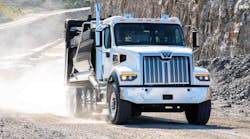What have been the major trends that have brought the truck equipment industry to where it is today? Jim Carney, NTEA executive director, raced through 40 years of industry history during the “Surviving and Thriving” session presented at The Work Truck Show.
It was a quick glimpse in the rearview mirror with a strong urge for industry companies to keep their eyes riveted on what might be coming down the road.
“We want to see some of the trends from the past that shaped our industry and look at the present,” Carney said. “But we really need to focus on the future. We just can't do things the way we used to do.”
Here is his view of industry history, decade by decade:
-
The 1960s were the heyday of the local body builder and truck equipment distributor. There were no strong national manufacturers and a yet-to-be-completed national highway system. Because shipping was difficult and time-consuming, local markets were safe from distant competitors.
For manufacturers, manufacturing technology was limited. CNC equipment did not exist. No computers were available to help companies run their businesses.
-
The 1970s saw truck equipment become a regulated industry. FMVSS, OSHA, and EPA all really began to grow during this decade. It also was the decade where product liability litigation really began to grow. Litigation and regulation combined to force the industry to become more sophisticated.
The farm market declined considerably during the 1970s. Farm body manufacturers such as Knapheide and Omaha Standard essentially had to reinvent themselves.
Light-duty trucks became widely accepted as consumer trucks and family vehicles. It was a decade of growth for truck sales.
-
The 1980s marked the start of the national market for truck equipment. Contributing to this: a better communications infrastructure, the national highway system was completed, and trade between Canada, the United States, and Mexico began to grow.
“The industry, however, remained fragmented,” Carney said. “There was still ease of entry, and there was a tremendous amount of competition coming into the business. Gross margins in 1984 were about 25% in this industry, based on the NTEA Distributor Operating Survey. In 1989, that had dropped a full percentage point to 24%. By 2000, gross margin had fallen to 23%. Our profits took a beating, and our industry has not been the same since then.”
Plenty of product lines were available for distributors to sell, however. “It was a good time to be in the industry,” Carney said. “There was a lot of growth.”
Also in the 1980s, companies such as Great Lakes Truck Equipment and Scherer Truck Equipment established chassis pools and ship-through programs. Chassis manufacturers began contacting fleets more regularly and began getting involved in selling commercial trucks.
This decade saw the rise of what Carney called the “mega-distributor,” companies with multiple locations that began to dominate specific regions.
-
The 1990s were a decade of major advancements in technology. Fax machines, Internet, and e-mail all made it easier to do business from a distance.
“Fleets began to merge and consolidate, particularly in the utility business,” Carney said. “With that, the customer — not product — was king.”
It also was a decade during which OEMs expanded pool and ship-through participation. Simultaneously, distributors began to lose lines of truck equipment that could be sold profitably.
“Distributors used to have a lot of profitable product lines,” Carney said. “Then manufacturers started selling those products direct. Think of the refuse industry, wreckers, utility equipment. Pickup accessories — bumpers, grille guards, winches — were major parts of a distributor's product line. The OEMs began incorporating those directly into their product offerings.”
Life in the fast lane
Ten years ago, NTEA conducted research that was quite similar to the project the association commissioned last year. Highlights are much the same as the most recent survey. Among the findings:
-
The roles in the distribution channel are blurring.
-
The truck chassis manufacturers are increasing their control over the supply and distribution of chassis.
-
Customers are demanding better service, quality, and accountability, but the required skilled labor to provide that service is diminishing.
-
The Internet is impacting how business is done.
-
Local markets are simultaneously consolidating and fragmenting. Acquisitions and mergers are increasing, and yet others are focusing on niche markets.
“The difference between 10 years ago and today is that things now seem to be happening at a much faster pace — like warp speed.”
In looking over 40 years of truck equipment industry history, Carney concluded that the industry has seen considerable consolidation, that distributors are under pressure now from all sides, and that some general truck equipment distributors have been forced to serve niche markets. However, he also believes that the industry has become more dynamic and innovative in response to competitive pressures.
“You can't do business the way you used to,” Carney said. “You have to be innovative, looking at your plan, and constantly changing your business.”








